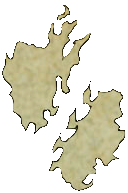Khom
This article is a Work in Progress and will be finished soon™
Biology
Anatomy
Khoms are extremely small, cuadruped, flightless avians. They have round, fluffy bodies covered in feathers, and a very small beak. They vary in colouration and pattern among subspecies, though all of them have areas of iridiscence, generally around the neck and in the males' train. Male khoms have more elaborate and colourful plumage than females, and during breeding season the adults develop a complex array of long iridiscent feathers in their tail, that they use for their mating displays.Behaviour
The khom is a simple, gregarious creature that lives in colonies of variable size. A group of khoms is known as a flash, due to how the iridiscent feathers on their neck can seem to "flash" when a group of them run away when surprised.They live in burrows, under bushes or in the many crevices of societarian houses.
They are primarily crepuscular or nocturnal. They have very good night vision.
Reproduction
Khoms reproduce rapidly, laying up to 8 clutches of eggs per year in hotter climates, with between 3 and 8 eggs per clutch that are incubated for around 12 days.They lay their eggs in burrows, holes and under structures, and both sexes incubate and care for the young, which will leave their nest at around 12 to 20 days old.
Diet
Grains, seeds and small bugs are the main diet of khoms, though they might consume fruits and flowers and, in the bigger subspecies, may even hunt other small creatures.They will gather and nest close to societarian food storages such as silos and barns, causing big losses.
Predators
Khoms are part of the diet of almost all small and medium sized predators in the archipelago. Hapists, lyraiks and mirkelins are some of their common threats.Geographic Distribution
Khoms are present in all islands of the Haan Archipelago, though their colonisation of the Larea islands is a more recent phenomenom, caused by individuals being brought into the islands by travelling in traders' ships.It is not known where did their population originate.
Relationship with Societarians
The khom has long been considered a pest in societarian settlements, for their vast numbers and their love for societarian's food.Erradication Efforts
Farmers across the Archipelago have resorted to numeros methods to try to keep the khoms at bay. The most common is the use of kennet or even toy lyraiks (And more rarely hapists), which are trained to hunt them and sometimes fed almost exclusively khoms to habituate them to the task. Traps, poisons and blocking of potential nest sites are other methods used, though none of them are especially effective.In Larea
The remote islands of Larea suffered a great environmental impact as traders from other islands brought with them exotic creatures and plants, including the khom. The new predators and competitors changed the landscape and caused the extintion of many local species, such as the lilac mjellic. For this reason, the native Lareans took action in the form of legislation and erradication efforts to restore the local ecosystem.Any khom found in Larea must be killed on sight, and any potential nest must be reported to the authorities.
Port towns are covered in traps and baits meant to destroy any khoms hidden in shipments and, while the posession of lyraiks is regulated or outright banned in some places of the island, khom hunters use trained kennet lyraiks to raid and destroy burrows.
Uses
Khoms have recently started to be kept and bred by societarians.Most of the captive bred khoms are used as feed for trained hapists and kennet lyraiks in training, but in smaller numbers they are kept as pets of the rich, or trained to perform simple tricks for entertainment groups. Khoms are also seen as a food item in some places, particularly in Stunveldt and Ruh, where they are caught and served in a variety of dishes, often cooked with the same grains they usually eat.
Lifespan
2 years
Average Height
7-10cm
Geographic Distribution





I love invasive shiny cuties :) Do they breed them only as food for the pets or did anyone try to eat them themselves?